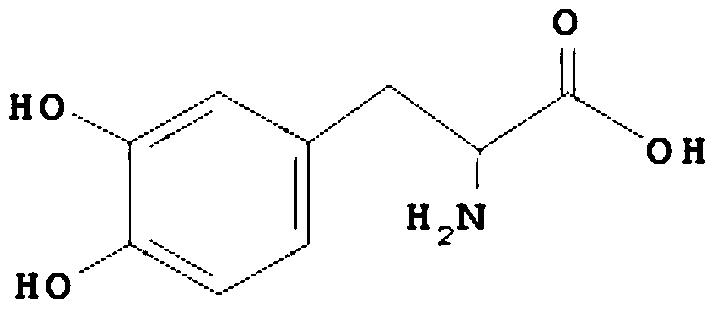Method for improving efficiency of catalytic production of L-dopa by tyrosine phenol lyase
A technology of levodopa and tyrosine phenol, which is applied in the field of enzyme catalysis, can solve the problems of low yield of L-DOPA, difficult control of reaction conditions, poor stability, etc., and achieve improved conversion rate and product concentration, low cost, The effect of improving product quality
- Summary
- Abstract
- Description
- Claims
- Application Information
AI Technical Summary
Problems solved by technology
Method used
Image
Examples
example 1
[0022] tyrosine phenol lyase
[0023] LB medium: tryptone 10g / L, yeast extract 0.5g / L, sodium chloride 10g / L, pure water.
[0024] Fermentation medium: tryptone 12g / L, yeast extract 24g / L, glycerin 5g / L, potassium dihydrogen phosphate 2.31g / L, dipotassium hydrogen phosphate trihydrate 16.43g / L, pure water.
[0025] 1) Pick a single colony and inoculate it into a 4ml LB medium test tube, add kanamycin (50mg / L), 37°C, 220rpm, and cultivate for 12h to obtain first-grade seeds;
[0026] 2) The primary seeds were inoculated into 100ml of fermentation medium shake flask, 37°C, 220rpm, cultured for 4h, added IPTG to a final concentration of 1mM, 25°C, 220rpm, cultured for 12h;
[0027] 3) Centrifuge the bacterial liquid in step (2) to collect the bacterial cells, and place in a -20°C refrigerator.
example 2
[0028] Example 2: Extraction of Tyrosine Phenol Lyase
[0029] 1) Add 3 times the volume of water to the bacteria, and ultrasonically disrupt the cells for 20 minutes;
[0030] 2) High-speed centrifugation to obtain supernatant enzyme liquid;
example 3
[0031] Example 3: Conversion of tyrosine phenol lyase to produce L-dopa
[0032] 1) 1L substrate solution: 14g / L sodium pyruvate, 10g / L catechol, 40g / L ammonium chloride, 2g / L sodium sulfite, 1g / L EDTA, adjust pH to 8.0;
[0033] 2) Add 10-100g of enzyme solution, add 1L of substrate solution, stir well, seal and shake at 25°C;
[0034] 3) Add a substrate (an equivalent amount of sodium pyruvate and quinone) every half hour, and control the substrate concentration of the two substrates to not be higher than 10g / L;
[0035] 4) When the product concentration reaches more than 20g / L, add 20g / L of crystals to induce a large amount of crystallization of the product in advance;
[0036] 5) When the residual concentration of catechol falls below 0.2g / L, stop the reaction, and the accumulated L-dopa concentration reaches above 130g / L.
[0037] 6) The reaction feed liquid is acidified with dilute sulfuric acid or dilute hydrochloric acid to dissolve the crystals, and then centrifuged...
PUM
| Property | Measurement | Unit |
|---|---|---|
| molecular weight | aaaaa | aaaaa |
Abstract
Description
Claims
Application Information
 Login to View More
Login to View More - R&D
- Intellectual Property
- Life Sciences
- Materials
- Tech Scout
- Unparalleled Data Quality
- Higher Quality Content
- 60% Fewer Hallucinations
Browse by: Latest US Patents, China's latest patents, Technical Efficacy Thesaurus, Application Domain, Technology Topic, Popular Technical Reports.
© 2025 PatSnap. All rights reserved.Legal|Privacy policy|Modern Slavery Act Transparency Statement|Sitemap|About US| Contact US: help@patsnap.com

